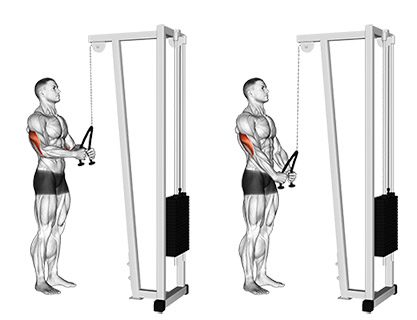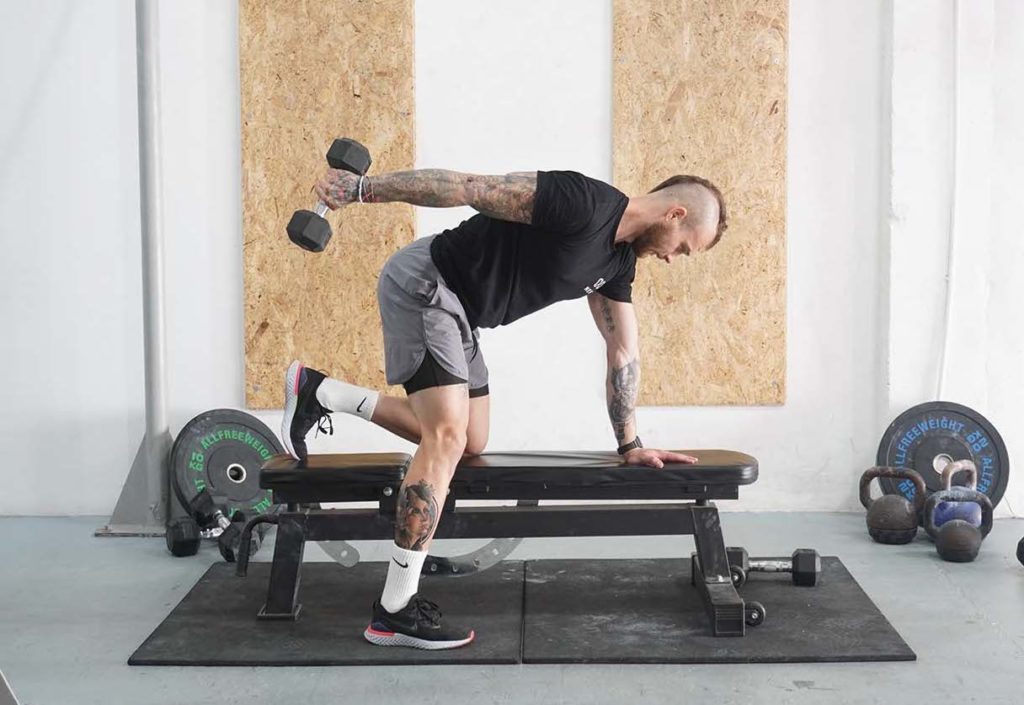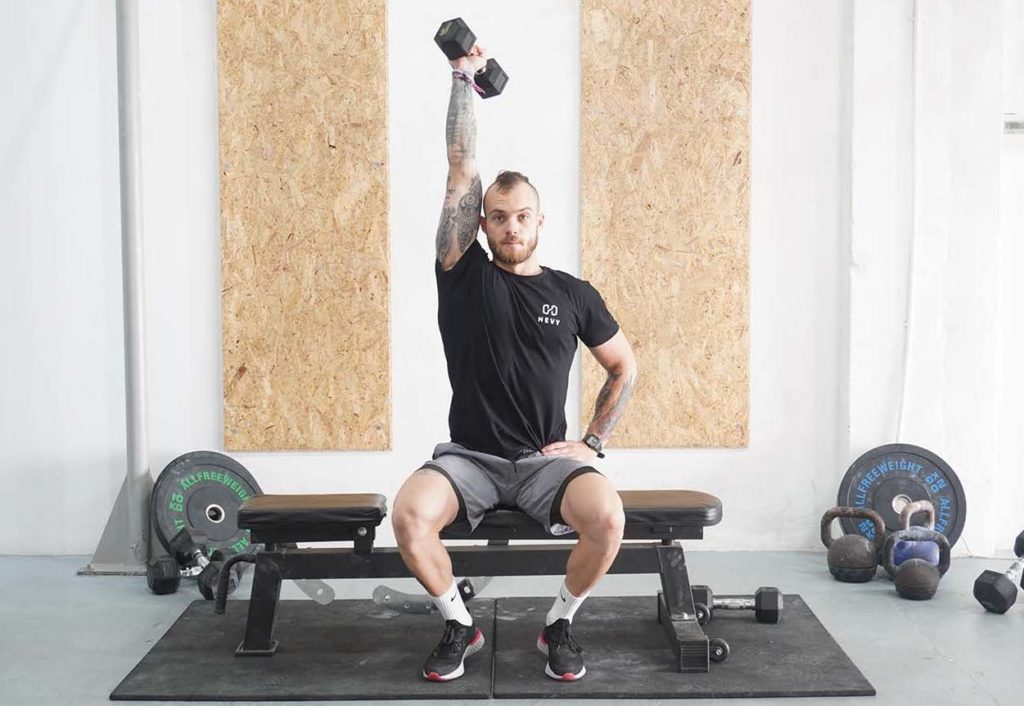The Benefits of the Dumbbell Skullcrusher
The dumbbell skullcrusher, also known as lying tricep extensions, is an isolation exercise that strengthens and develops your triceps. Despite its unusual name, the skullcrusher is a safe, fun, and, most importantly, effective movement to include in your training.
To perform a skullcrusher, you must grab a pair of dumbbells, lie on a flat bench, straighten your arms and position the weights above your head. Once in position, bend your elbows to lower the dumbbells to the sides of your head. Next, extend your arms fully and prepare for the next repetition.
One of the most notable benefits of skullcrushers is the excellent stretch of the tricep as you bend your arms. The long tricep head crosses the shoulder joint, bringing your arms up and bending your elbows, causing a significant growth stimulus.
Another notable benefit of the movement is that it targets and isolates your triceps well, even if you don’t have access to fancy training equipment. You need a pair of dumbbells and a flat surface to lie on to train and grow your triceps. Using dumbbells for the movement is beneficial because it forces both arms to work independently, leading to more balanced development.
On top of that, the skullcrusher strengthens your triceps, making everyday activities like lifting objects overhead and reaching up more accessible. Strong triceps improve your gym performance and make you more competitive in sports like basketball.
We recommend including the dumbbell skullcrusher near the end of your tricep or push routine. Pick light dumbbells that allow you to perform at least twelve smooth and controlled repetitions, and avoid using jerking motions.
Level of Exercise: Beginner/Intermediate
How to do a Dumbbell Skullcrusher

- Grab a pair of light dumbbells and sit on the edge of a flat gym bench.
- Rest the dumbbells on your thighs and flex your arms for an extra secure grip.
- Bring your shoulders back, engage your abs, and lie back as you bring the dumbbells close to your chest.
- As you lie on the bench, extend your arms to position the dumbbells over your head. Keep your palms neutral (facing one another).
- Take a breath and lower the dumbbells to the sides of your face by bending your elbows.
- Bring the dumbbells down until your elbows are at a 90-degree angle and you feel a stretch in your triceps.
- Hold the bottom position for a moment and extend your elbows simultaneously, bringing the dumbbells to the top.
- Exhale near the top and contract your triceps.
- Take another breath and repeat.
Once finished, engage your upper body to raise your torso off the bench as you bring the dumbbells to your lap. Don’t drop the weights to the floor from a lying position because that can stress your shoulders.
What muscles does a dumbbell skullcrusher activate?
The primary muscles that work during dumbbell skullcrushers are the triceps, which make up the rear of the upper arms and produce elbow extension (straightening of the arms) (1, 2). Our triceps muscle engages as we start bringing the dumbbell down and becomes increasingly active as we extend our arm to complete each repetition. As mentioned above, the long triceps head crosses the shoulder joint, contributing to stability during a skullcrusher.
Our shoulders (deltoids) are the second muscle group in dumbbell skullcrushers (3). These muscles flex isometrically to provide support at the shoulder joint, allowing our arms to remain steady while doing repetitions.
The midsection musculature also contributes to a lesser degree during the skullcrusher. Our abs, obliques, and other muscles in the area flex isometrically, contributing to upper body rigidity and making us feel stabler and more secure. Similarly, the upper back muscles engage to keep our shoulder blades retracted and scapula stable throughout each set.
Expert Tips on Proper Form
An essential tip for effective skullcrushers is to pick dumbbells you can control well. Your chosen weights should allow you to perform at least 12 smooth and controlled repetitions. You must lower the dumbbells enough to stretch your triceps and follow that up with a strong extension. Doing so is crucial for making each repetition more effective and reducing the risk of ego lifting, which tends to be common with isolation exercises.
Our second tip for skullcrushers is to establish a solid base before performing the movement. In other words, you must retract your shoulder blades and dig them into the bench as you set up for the exercise. That way, your scapula will remain stable, leading to better shoulder stability and steady upper arms, allowing you to put all your efforts into bending and extending your elbows.
The third tip to keep in mind for skullcrushers is to keep your elbows steady from start to finish. Lower and raise the weights by bending and extending your arms but avoid moving your elbows back and forth as you do so. Performing controlled repetitions will allow you to keep the tension on your triceps rather than having other muscle groups (such as the deltoids) help.
Our fourth tip for dumbbell skullcrushers is to bring the dumbbells to the sides of your head. The movement is called ‘skullcrusher,’ but it doesn’t mean you should risk dropping a weight on your face.
Plus, having the dumbbells descend to the sides of your face allows you to bend your elbows more and cause a stronger stretch that contributes to growth. It also keeps your arms aligned and prevents you from unnecessarily bringing your hands together in an awkward and uncomfortable position.
The final recommendation for skullcrushers is to keep your elbows in and avoid flaring them, which allows you to keep tension on your triceps and force them to do all of the work. In addition, flaring the elbows removes the pressure from your triceps, making skullcrushers less beneficial.
Dumbbell Skullcrusher Variations and Modifications
1. EZ Bar Skullcrusher
EZ bars have a wide letter M shape and offer multiple grip options for trainees. These bars are particularly beneficial for biceps and triceps exercises because they take the stress away from your wrists, allowing you to train safely and without pain. To perform the movement, load the EZ bar, grab it evenly using a narrow grip, lie back, and extend your arms. Next, retract your shoulder blades, engage your abs, take a breath, and bend your arms, bringing the EZ bar behind your head. Finally, straighten your arms as you exhale and repeat.
2. Straight Bar Skullcrusher
Straight bar skullcrushers are similar to the EZ bar version. You’re training through a similar range of motion, working both triceps simultaneously and using an identical load. The only difference is that you’re using a straight bar, which can cause some wrist stress for some trainees. It never hurts to try skullcrushers with a straight bar and see if you can do the movement comfortably.
3. Cable Skullcrushers
Cable skullcrushers are another fantastic variation for developing your triceps. Using a cable leads to constant tension on your triceps, preventing the muscle from having any time to rest during sets. Attach a straight bar or rope to a low pulley and position a flat gym bench to be in line with the cable station. There should be some distance between the edge of the bench and the pulley. Proceed by setting the load, grabbing the attachment, and lying on the bench with your head facing the cable station. Extend your arms, retract your shoulder blades, take a breath, and lower the weight by bending your elbows. Straighten your arms and exhale near the top.
Mistakes to Avoid
Using too Much Weight
One of the most common errors with skullcrushers is using too much weight, preventing you from controlling the dumbbells effectively. As a result, you’re more likely to shorten the range of motion, use momentum, or jerk the weight to complete more repetitions. Unfortunately, doing so makes repetitions less effective even though you’re using more weight. Plus, jerking motions and momentum can place unnecessary stress on your joints and connective tissue, increasing the risk of nagging aches down the road. A much better approach is to start with light dumbbells to learn the movement and increase the load gradually until you’re doing 12 to 20 reps per set.
Moving Your Elbows Back and Forth
The second common error with skullcrushers is one we discussed briefly above. Trainees often move their elbows back and forth, shortening the range of motion and placing less tension on their triceps. For instance, as trainees bend their elbows, they also move them back, tricking themselves into believing they are training with proper form. Then, as they extend their elbows, their arms travel in the opposite direction, taking some pressure away from the triceps. Avoid the error by keeping your elbows stationary as you bend and straighten your arms, even if that means using lighter dumbbells.
Not Controlling the Descent
The third common mistake with skullcrushers is simply letting the weight drop to the bottom position with no control. Trainees often focus on lifting the weight but ignore the lowering portion and miss out on the eccentric contraction (muscle lengthening passively under load). Doing so leads to a less potent growth stimulus and poor results. Plus, dropping the weight might lead to stress in your elbows and connective tissues. Avoid the mistake by maintaining a consistent tempo on all reps, lifting and lowering the weight with the same speed.
Similar Exercises to the Dumbbell Skullcrusher
Triceps Rope Pushdown

Triceps rope pushdowns are exercises you perform on a cable machine by holding a rope attachment. Because of its difficulty, the movement forces you to pick the correct load and maintain proper technique, resulting in superior triceps activation and growth. You can also perform the exercise by holding the rope with one hand at a time, and that can be helpful for people dealing with side-to-side muscle imbalances.
Triceps Kickback

Similar to skullcrushers, triceps kickbacks are a fantastic isolation exercise you perform with dumbbells. The objective is to grab a pair of dumbbells, bend forward, and raise your arms to torso level. Once in position, take a breath and extend your arms by contracting your triceps. Next, hold the top position for a moment and lower the dumbbells slowly while keeping your upper arms in line with your torso.
One Arm Tricep Extension (Dumbbell)

One arm overhead triceps extensions are another excellent isolation exercise (2). The objective is to grab a dumbbell, lift it overhead, and engage your abs. Once in position, take a breath and lower the weight behind your head while keeping your elbow steady. Descend until you feel a stretch in your triceps and extend your arms, exhaling near the top. Do as many repetitions as possible and repeat the sequence with your other arm.

